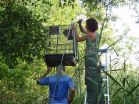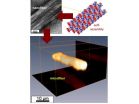(Press-News.org) CHAMPAIGN, Ill. — Here are three disaster scenarios for zoo or aquarium managers: One, a wildfire lunges towards your facility, threatening your staff and hundreds of zoo animals. Two, hurricane floodwaters pour into your basement, where thousands of exotic fish and marine mammals live in giant tanks. Three, local poultry farmers report avian influenza (bird flu) in their chickens, a primary source of protein for your big cats.
What do you do?
These are among the many potential disasters the managers of zoos and aquariums ponder in their emergency preparedness drills and plans. But these stories are not just worst-case scenarios: The events described above actually happened, and the aftermath – often heroic, and sometimes tragic – depended in large part on the institutions' preparedness training, planning and forethought in calmer times.
When bad weather strikes or illness invades, zoos and aquariums are among the most vulnerable facilities affected, said University of Illinois veterinarian Yvette Johnson-Walker, a clinical epidemiologist who contributes to emergency response training efforts at animal exhibitor institutions. She is a clinical instructor in the department of veterinary clinical medicine at Illinois, and lead author of a new paper on emergency preparedness at zoos and aquariums in the journal Homeland Security & Emergency Management.
Some animals are likely to suffer if the electricity goes out for long, she said. Others are large, skittish and dangerous under normal conditions.
Training caretakers and keepers to minimize their own risks while attending to their animals in an emergency is a challenge, but leads to the best outcomes, she said.
In 2012, Johnson-Walker joined forces with Yvonne Nadler, a project manager with the Zoo and Aquarium All Hazards Preparedness Response and Recovery Center, to bring vital emergency training to accredited animal exhibitor institutions in Illinois, Indiana and Missouri. This effort, funded by the U.S. Department of Agriculture and supported by the END
Flu at the zoo and other disasters: Experts help animal exhibitors prepare for the worst
2014-10-23
ELSE PRESS RELEASES FROM THIS DATE:
Shorter TB treatment not a successful alternative
2014-10-23
A clinical drug trial conducted in five Sub-Sahara African countries shows that a shortened (four month) treatment for tuberculosis (TB) is well tolerated and may work well in subsets of TB patients, but overall could not be considered as an alternative to the current six month standard treatment. The results of the study were published in the New England Journal of Medicine.
TB remains a significant public health problem worldwide. There were an estimated 8.6 million people who developed TB and 1.3 million died from the disease in 2012. The study was designed to verify ...
New, faster therapeutic hypothermia techniques
2014-10-23
New Rochelle, NY, October 23, 2014–Rapid lowering of body temperature following an acute myocardial infarction (MI) can be an effective therapeutic strategy to minimize damage to the heart muscle caused by the loss and restoration of blood flow to the heart. While hypothermia shows clinical promise, current methods to cool the heart are insufficient. Faster, more effective techniques are needed to realize the full cardioprotective potential of this emerging intervention, as described in an article in Therapeutic Hypothermia and Temperature Management, a peer-reviewed ...
Study: Many in US have poor nutrition, with the disabled doing worst
2014-10-23
CHAMPAIGN, Ill. — A new study finds that most U.S. adults fail to meet recommended daily levels of 10 key nutrients, and those with disabilities have even worse nutrition than average.
An estimated 10 to 25 percent of U.S. adults fit into one or more category of disability, from those who have difficulties with activities of daily living, such as dressing, bathing and eating, to those who cannot use their legs or struggle to accomplish routine tasks, such as money management or household chores.
To determine how these physical or mental difficulties can affect ...
Birds roosting in large groups less likely to contract West Nile virus
2014-10-23
URBANA, Ill. – Although it would seem logical that large numbers of roosting birds would attract more mosquitoes that carry West Nile virus and contract the disease when bitten, recent research at the University of Illinois found the opposite to be true. That is, when large groups of birds roost together the chances that an individual bird will get bitten by mosquitoes carrying West Nile virus and subsequently contract the disease actually go down.
"Our study is the first field-based evidence to support what's called the 'encounter-dilution effect' acting in a ...
Lucky star escapes black hole with minor damage
2014-10-23
COLUMBUS, Ohio: Astronomers have gotten the closest look yet at what happens when a black hole takes a bite out of a star—and the star lives to tell the tale.
We may think of black holes as swallowing entire stars—or any other object that wanders too close to their immense gravity. But sometimes, a star that is almost captured by a black hole escapes with only a portion of its mass torn off. Such was the case for a star some 650 million light years away toward Ursa Major, the constellation that contains the "Big Dipper," where a supermassive black hole tore ...
Cornell chemists show ALS is a protein aggregation disease
2014-10-23
Using a technique that illuminates subtle changes in individual proteins, chemistry researchers at Cornell University have uncovered new insight into the underlying causes of Amyotrophic Lateral Sclerosis (ALS).
Brian Crane, professor of chemistry and chemical biology, led one study and co-authored a follow-up on a spectroscopic method that detects subtle changes to copper-containing proteins in solution. He and Jack Freed, professor of physical chemistry, have developed the method together with Petr Borbat, associate director of Cornell's National Biomedical Center for ...
Reminiscing can help boost mental performance
2014-10-23
ITHACA, N.Y. – To solve a mental puzzle, the brain's executive control network for externally focused, goal-oriented thinking must activate, while the network for internally directed thinking like daydreaming must be turned down to avoid interference – or so we thought.
New research led by Cornell University neuroscientist Nathan Spreng shows for the first time that engaging brain areas linked to so-called "off-task" mental activities (such as mind-wandering and reminiscing) can actually boost performance on some challenging mental tasks. The results advance ...
NYU researchers break nano barrier to engineer the first protein microfiber
2014-10-23
Researchers at the New York University Polytechnic School of Engineering have broken new ground in the development of proteins that form specialized fibers used in medicine and nanotechnology. For as long as scientists have been able to create new proteins that are capable of self-assembling into fibers, their work has taken place on the nanoscale. For the first time, this achievement has been realized on the microscale—a leap of magnitude in size that presents significant new opportunities for using engineered protein fibers.
Jin Kim Montclare, an associate professor ...
Fires in the southern United States
2014-10-23
In this image taken by the Aqua satellite of the southern United States actively burning areas as detected by MODIS's thermal bands are outlined in red. Each red hot spot is an area where the thermal detectors on the MODIS instrument recognized temperatures higher than background. When accompanied by plumes of smoke, as in this image, such hot spots are diagnostic for fire. These fires are a combination of small wildfires and prescribed fires. On the U.S. Forest Service website a prescribed fire is set to reduce tree overcrowding, revive fire-dependent species and reduce ...
National report finds bullying in schools still prevalent
2014-10-23
Despite a dramatic increase in public awareness and anti-bullying legislation nationwide, the prevalence of bullying is still one of the most pressing issues facing our nation's youth, according to a report by researchers from Clemson University and Professional Data Analysts Inc., and published by the Hazelden Foundation.
"Bullying continues to affect a great number of children in all age groups, with the highest prevalence observed in third and fourth grades, where roughly 22 percent of schoolchildren report that they are bullied two or three times or more per month," ...






